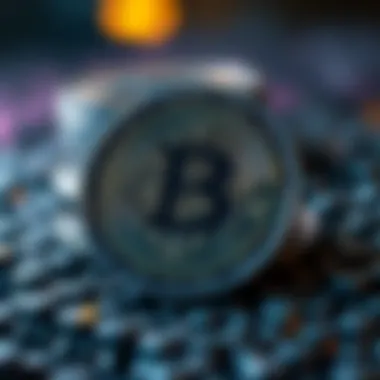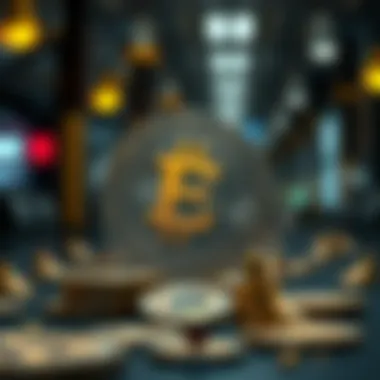ERC721 Tokens: Exploring Their Role and Impact


Intro
In the ever-evolving realm of digital currencies and assets, the nuances of how ownership and value are interpreted can be bewildering. Among the array of technologies that shape this landscape, ERC721 tokens stand out as a defining hallmark of non-fungible tokens. Unlike their fungible counterparts, which are interchangeable like a dollar bill or a gold coin, ERC721 tokens represent unique assets, paving the way for a variety of applications, from art and collectibles to real estate.
As an enthusiastic reader, whether you're a novice or a seasoned investor, you'll find this comprehensive overview highly beneficial. It serves not only as a guide to the technical aspects of ERC721 but also as a lens through which to understand the broader implications these tokens have on digital ownership and asset representation.
What makes ERC721 tokens indispensable in today's economy? In this exploration, we will dissect their structure, functionality, and significance within the blockchain ecosystem. We will delve into their role in redefining ownership in a digital age, as well as the challenges and trends that accompany their increasing prominence.
The importance of grasping these concepts cannot be overstated, especially in an age where digital assets are gaining legitimacy. So, let's embark on this journey together as we unravel the complexities and promise of ERC721 tokens.
Prologue to ERC721 Tokens
In the ever-evolving landscape of digital assets, ERC721 tokens stand out by taking ownership to a whole new level. This introduction delves into their significance, providing a foundational understanding of non-fungible tokens and the ERC721 standard that underpins them. Grasping these concepts sets the stage for comprehending how these tokens impact various industries and the digital economy as a whole.
ERC721 tokens form the backbone of the non-fungible asset realm, where each token is distinct and irreplaceable. Unlike their fungible counterparts, such as Bitcoin or Ethereum, which can be exchanged one-for-one, each ERC721 token carries its own unique value and characteristics. This uniqueness transforms how we think about ownership and asset representation in the digital world.
Let's dissect some layers of this topic:
- Uniqueness: With ERC721 tokens, every asset can be distinctly identified. This is crucial in environments like art or collectibles, where each item demands its own identity and provenance.
- Applications: They stretch beyond art and entertainment; real estate, gaming, and even academic credentials are increasingly adopting this model. The versatility of ERC721 tokens showcases their relevance across diverse sectors.
- Interoperability: Built on Ethereum, ERC721 tokens benefit from a broader ecosystem of decentralized applications. This tech-savvy framework facilitates smooth integration, creating opportunities for both creators and investors.
"ERC721 standard has altered the perception of digital ownership—it's not just about having something but being the sole controller of that unique piece in a digital world."
With all these elements considered, it's clear that the understanding of ERC721 tokens is vital for investors, developers, educators, and enthusiasts alike. The rise of these tokens moves us a step closer to a future where digital assets are treated with the same seriousness as their physical counterparts. This paves the way for innovations and transformations that may redefine values and ownership in the years to come.
Defining Non-Fungible Tokens
Non-fungible tokens, or NFTs, represent something that is one of a kind. In economic terms, this means they can't be substituted for one another. Just as an original painting cannot be traded for a mere print, NFTs carry inherent qualities that mark them as unique—whether it’s a specific digital artwork, a limited edition collectible, or even virtual real estate. Each NFT encapsulates distinctive information recorded on the blockchain, which is what gives them their uniqueness and value.
In practical terms, non-fungible tokens are a new form of digital scarcity. This notion has significant implications across multiple fields. Artists can sell their work in ways that were not possible before, and collectors can showcase their ownership over rare digital items. Additionally, with the emergence of platforms like OpenSea or Rarible, the buying and selling of NFTs have become much more accessible, enhancing market dynamics.
The Emergence of ERC721 Standard
The ERC721 standard was formulated to address the need for non-fungible tokens on the Ethereum blockchain. Before its establishment, the token landscape was primarily dominated by fungible tokens, which standardized transactions for cryptocurrencies. As interest in unique digital assets surged, a framework was needed to facilitate the creation, transfer, and management of heterogeneous tokens.
The proposal for ERC721 emerged in January 2018, and since then, it has become the de facto protocol for NFTs. This standard ensures that tokens can be tracked and traded, facilitating their usefulness across dapps and marketplaces. With ERC721, developers have the flexibility to implement features tailored to their projects, which has sparked a wave of creativity and innovation in the digital asset space.
Consequently, understanding the origins and capabilities of the ERC721 standard is crucial for anyone looking to navigate the burgeoning world of NFTs. By establishing a common ground, it enables developers to craft solutions that better connect creators, collectors, and investors, encouraging a robust ecosystem where uniqueness holds immense value.
For more information about ERC721 tokens and their applications, you might explore resources from Wikipedia or Investopedia.
\n
The Technical Framework of ERC721
The technical framework of ERC721 tokens stands as the bedrock for understanding their functionality and significance within the blockchain ecosystem. This section dives into the core technologies that facilitate the existence of these tokens, examining how they leverage blockchain capabilities alongside smart contracts. The importance of the technical constructs not only lies in the seamless user experience but also in ensuring security, transparency, and the unique characteristics that differentiate ERC721 from other token standards.
Underlying Technology: Blockchain
At its core, the ERC721 standard relies on blockchain technology to ensure the integrity and authenticity of digital assets. Blockchains serve as decentralized ledgers that record transactions across a network of computers. They prevent alteration or deletion of data, making them ideal for managing ownership of unique assets.
For ERC721 tokens, the Ethereum blockchain is the most commonly used environment. This network enables the creation, transfer, and management of non-fungible tokens, offering diverse applications ranging from digital art to virtual real estate. The immutability feature of blockchain means once an ERC721 token is minted, its details—such as ownership and transaction history—remain permanently recorded. This brings a layer of trust that is paramount in digital ownership.


Understanding Smart Contracts
Smart contracts are self-executing programs that run on the blockchain. They automatically enforce and execute the terms of an agreement without the need for intermediaries. In the case of ERC721 tokens, smart contracts define the properties and actions associated with the digital assets.
These contracts handle tasks such as minting new tokens, transferring ownership, and even executing royalties for creators. Smart contracts also contribute to the transparency of actions involving ERC721 tokens, as every transaction is publicly recorded on the blockchain. This reduces the chance of fraud, allowing buyers and sellers to engage with confidence and clarity.
Key Attributes of ERC721 Tokens
Uniqueness
One of the standout features of ERC721 tokens is their inherent uniqueness. Every token has distinct information attached to it, from metadata defining its properties to a unique token ID. This contrasts sharply with fungible tokens, which are interchangeable and identical.
The key characteristic of uniqueness enables artists, musicians, and content creators to tokenize their work, granting each piece its distinct value. The uniqueness of an ERC721 token makes it a beneficial choice for representing art, collectibles, and other digital assets, effectively transforming the way ownership is perceived in the digital realm. However, this uniqueness comes with its own challenges, like valuation difficulties since buyers must ascertain the worth of an individual piece—this often leads to volatility in the market.
Indivisibility
The indivisibility of ERC721 tokens means they cannot be split into smaller units. Unlike Bitcoin, which can be divided down to the last satoshi, an ERC721 token exists as a complete entity.
This aspect plays a critical role in asset representation. For instance, a token representing a piece of artwork cannot simply be fractionalized and sold in parts; it stands alone in its entirety, which asserts its value in the market. While this feature solidifies value perception, it may be seen as a limitation for smaller investors who wish to participate in high-value purchases without the means to buy entire assets.
Ownership Proof
Ownership proof is another fundamental attribute of ERC721 tokens, providing irrefutable evidence that a specific individual holds a unique digital asset. This proof is integrated into the token's metadata and encoded in the blockchain—a decentralized verification mechanism.
Such evidence is advantageous as it not only simplifies the process of transferring ownership but also minimizes disputes regarding authenticity. It ensures the rightful owner can make transactions securely, and helps maintain a robust market for digital assets. The challenge here lies in educating users from traditional asset spaces about this new form of ownership proof, as they may be accustomed to different verification systems.
"The digital ownership provided by ERC721 tokens is unlike any traditional asset, offering unprecedented security and clarity in transactions."
The exploration of these key attributes illuminates the fundamental reasons ERC721 tokens have carved out their niche within the broader ecosystem. As users continue to adapt to the digital age, understanding the technical underpinnings of these tokens becomes crucial for all involved parties, from developers and investors to collectors.
The Role of ERC721 in Digital Ownership
ERC721 tokens have become significant players in the ongoing discussion around digital ownership. In a world where everything from art to real estate claims a stake in online spaces, understanding the role of these tokens is crucial. They empower individuals and organizations to assert ownership of unique digital items, offering a level of security and veracity that traditional forms of ownership often lack. Thus, they pave the way for new business models and opportunities, reshaping how we interact with digital assets.
Asset Representation and Tokenization
At its core, ERC721 enables the tokenization of assets, transforming tangible and intangible items into unique digital counterparts. Think about it: the artwork you value can now exist in the form of a token that proves your ownership without ambiguity. This leads to a democratization of investment, where even the smallest player can have a stake in high-value assets.
The essence of tokenization is that it creates a digital representation that stands apart from fungible tokens. Each token possesses distinct characteristics, meaning no two tokens can be exchanged at equal value. This is crucial for artworks, collectibles, and even intellectual property, where uniqueness is the name of the game.
Take, for example, a rare baseball card. If converted into an ERC721 token, the card’s digital avatar can inform potential buyers about its history, condition, and authenticity. Everything is transparent and auditable on the blockchain, reducing chances of dispute. This lays the groundwork for future dealings and interactions, all facilitated by digital proofs of ownership.
Impact on Art and Collectibles
The art and collectibles market has witnessed a radical shift since the introduction of ERC721 tokens. Artists now have the ability to release their work as non-fungible tokens, therefore ensuring that each piece is unique and verifiable. More artists are embracing the tokenization of their work as a viable means to reach their audience and earn a living.
Beyond revenue, this mechanism also fosters a direct relationship between creators and collectors. By owning a piece of digital art, collectors are not just purchasing an image; they gain access to a new layer of provenance. As the saying goes, “a picture is worth a thousand words,” but an ERC721 token comes with a story—its history of ownership, sales, and authenticity rights—all trackable via the blockchain.
However, the market also faces challenges. Not every piece translates well into the digital realm. The question of what constitutes “art” has broadened, opening avenues for varying perspectives on value.
"Tokens breathe new life into the concept of ownership; they ensure a layered understanding of asset value in an increasingly digital economy."


Real Estate and ERC721 Applications
One area gaining traction is real estate. Imagine owning a piece of property where transactions are streamlined through ERC721 tokens. Each property could have a token representing it that allows for fractional ownership and easier resale. This could significantly reduce barriers to entry, drawing in a wider array of investors.
In practice, this might mean that a luxury condo in Manhattan could be tokenized, allowing multiple individuals to own fractions of it without dealing with traditional real estate complications. Filing paperwork, long negotiation processes, and high entry costs could be mitigated through technology. Moreover, transparency regarding ownership is heightened as the blockchain ledger remains immutable yet accessible.
In summary, the role of ERC721 tokens in digital ownership cannot be overstated. They redefine asset ownership, delivering transparency and security while addressing the complexities of diverse markets. Their varied applications across fields, from art to real estate, highlight their versatility and the transformational capacity they have within our digital world.
Market Dynamics of ERC721 Tokens
Understanding the market dynamics of ERC721 tokens is essential when exploring how these unique assets function within the broader blockchain landscape. This topic reaches far beyond mere numbers. The dynamics encapsulate the interplay between investors, artists, and platforms, all of which define the NFTs' market position.
The interplay of these factors shapes the investment landscape. Savvy investors recognize that ERC721 tokens are not just assets; they are a cultural phenomenon rich with potential. From digital collectibles to exclusive art, the valuation can fluctuate dramatically based on trends, artist notoriety, and platform reputation. As such, keeping an eye on market movements and understanding economic principles related to scarcity and uniqueness becomes paramount.
Investment Trends and Valuation
The valuation of ERC721 tokens is influenced by several critical trends. One prominent trend is how artists and creators leverage these tokens to gain recognition and financial rewards. Artists are now equipped to represent their work secure and verifiably. This niche market encourages both seasoned investors and newcomers, each eager to grasp what certain tokens might be worth tomorrow.
- The scarcity of tokens leads to increased demand, especially for those perceived as culturally significant.
- Seasonal trends in digital art affect valuations, as holiday-themed NFTs or those launched during major events often see surges in interest.
- Social media plays a pivotal role in promoting certain trends, making it vital for investors to stay engaged with platforms like Twitter and Reddit, where discussions about upcoming art drops frequently occur.
The Role of Artists and Creators
Artists and creators serve as the backbone of the ERC721 marketplace. They not only provide the content but also infuse their own narratives into the tokens.
- Their ability to create limited editions or collaborate with other artists makes the market vibrant.
- The direct sales model allows creators to skip the middleman, putting them in a stronger financial position. This shift has proven beneficial for many artists, prompting more to enter the space.
- Furthermore, communities often rally around creators, fostering a sense of belonging and a shared investment in their success, which can significantly impact the value of their tokens.
Platforms for Trading ERC721 Tokens
Trading platforms play a vital role in the ecosystem of ERC721 tokens. They serve as the conduits through which these assets change hands, each with its nuances and utilities.
Marketplaces
Marketplaces like OpenSea and Rarible have become household names for NFT trading. These platforms thrive on user inclusivity and accessibility. They enable users to buy or sell tokens with ease, reinforcing trust through smart contracts.
- One key characteristic of these marketplaces is their ability to exhibit a wide variety of offerings.
- They often provide tools for valuation, analysis, and community interaction, which adds layers of engagement for users.
- However, they can also have drawbacks, such as high transaction fees and a sometimes overwhelming selection process that may baffle newcomers.
Peer-to-Peer Transactions
Peer-to-peer transactions present a different avenue for trading ERC721 tokens, promoting direct engagement between buyers and sellers. This model bypasses intermediary marketplaces, allowing for more personalized exchanges.
- A distinct characteristic of these transactions is the autonomy it grants users; sellers set their prices, and buyers can negotiate directly.
- Peer-to-peer connections foster a more intimate market experience, often enhancing trust and transparency.
- Yet, this approach carries its risks, such as a lack of regulatory oversight and possible fraud, making it crucial for participants to exercise caution when engaging in direct trades.
"In the vibrant world of ERC721 tokens, understanding the marketplace dynamics is as crucial as knowing the art itself."
In summary, the market dynamics surrounding ERC721 tokens are multi-faceted and ever-evolving. Investors, artists, and trading platforms interact within a rich tapestry that continuously reshapes how value is perceived, experienced, and exchanged. Staying informed about these dynamics allows for more informed decisions, ultimately enhancing the potential to navigate this fascinating and complex market.
Challenges and Limitations of ERC721 Tokens
The landscape of ERC721 tokens, while promising and innovative, is not without its bumps in the road. Understanding these challenges is crucial for anyone delving into the world of non-fungible tokens. Investors, creators, and developers alike must navigate numerous hurdles that could impact not just individual projects but the overall ecosystem. Below, a closer look at the key challenges collaboratively faced in this ever-evolving digital space.
Scalability Issues


One of the primary hurdles facing ERC721 tokens is scalability. As adoption increases, the demand for transactions on the Ethereum blockchain grows immensely. Each ERC721 token requires its own transaction, significantly burdening the network. For example, during peaks like the launch of a high-profile NFT drop, the network can become congested, leading to slow transaction times and skyrocketing gas fees. The Ethereum community grapples with finding efficient solutions, such as Layer 2 scaling solutions, to alleviate these issues without compromising the integrity of the blockchain.
Additionally, the ability to scale effectively raises concerns among investors regarding future growth. If the network can't handle increased use, it could deter potential adopters who are curious about the technology but wary of its performance risks. The delicate balance of scalability versus security becomes a pressing concern that many in the blockchain community must address.
Legal and Regulatory Considerations
Navigating the legal landscape surrounding ERC721 tokens is another formidable challenge. The ambiguity in the classification of these tokens can lead to a myriad of legal questions. Are they treated as securities? How do copyright laws factor into ownership? Perhaps it's not quite clear, which creates unease for developers and traders alike.
For instance, in some jurisdictions, regulations may evolve rapidly, leaving both creators and investors scrambling to comply. Tokens that initially seemed compliant may find themselves under scrutiny from governmental bodies. This uncertainty can stifle innovation and make potential investors skeptical about pouring resources into projects that might one day be viewed as non-compliant.
Moreover, intellectual property rights in the digital realm offer another layer of complexity. Determining the original creator's rights versus those of NFT holders requires nuanced understanding. The legal ramifications could be profound, potentially impacting the marketplace dynamics and user confidence in participating.
Environmental Impact of Blockchain Technologies
The environmental impact of blockchain technology is becoming an increasingly hot topic. With Ethereum's proof-of-work system, the energy consumption for validating ERC721 transactions can be significant. Critics often point to the carbon footprint associated with blockchain activities, arguing that the technological advancements are at odds with global climate initiatives.
This growing concern has prompted calls for more sustainable alternatives. The transition to proof-of-stake is being discussed as one potential solution. However, many ERC721 projects still operate on the existing proof-of-work model, leading to criticism from eco-conscious stakeholders. The challenge lies in balancing the demand for digital assets with environmental responsibility, something the community is gradually waking up to.
The Future of ERC721 Tokens
As we look ahead, the significance of understanding ERC721 tokens cannot be overstated. These tokens are at the forefront of a revolution in ownership and digital interaction that is only just beginning to unfold. The potential of ERC721 tokens lies in their uniqueness and the innovations that continue to sprout in this vibrant environment. Not only do they redefine how we perceive ownership in the digital realm, but they also bring forward a host of benefits and considerations that deserve attention.
Emerging Trends
The landscape of ERC721 tokens is evolving rapidly, and several key trends indicate where it may head next. Among the more exciting developments is the rise of fractional ownership. This concept allows multiple people to hold a share in a single token. It democratizes access to high-value assets that once only the well-off could acquire. Imagine a famous piece of digital art or a unique collectible that anyone, from a casual buyer to a serious investor, can contribute towards. This creates a blend of community and ownership previously unseen.
Another significant trend is the integration of interoperability among various platforms. As collectors grow diverse in their interests, the demand for flexibility in how these assets can be displayed and utilized across different ecosystems has surged. As it stands, users want to move their assets seamlessly from one marketplace or platform to another without hiccups. Innovations that address this desire will likely lead to more user-friendly experiences and broader adoption overall.
"The digital landscape continues to shift beneath our feet, creating new terrains for innovation and ownership in ways unimagined."
Potential Innovations in ERC721 Standards
The evolution of the ERC721 standard itself opens the door for considerable innovation. Enhancements aimed at increasing efficiency and reducing energy consumption are on the horizon. These updates can streamline transactions, thus making it easier for users to buy, sell, and trade tokens while minimizing environmental impact. Furthermore, upgrades integrating advanced metadata options could empower creators. This means more sophisticated data could be stored within the token itself, such as usage rights or royalty structures.
In addition, efforts to strengthen security through newer cryptographic methods could protect users against malicious activities, fraud, and hacking incidents – issues that have plagued digital asset ownership to date. Secure ownership will only foster greater trust and encourage wider acceptance of ERC721 tokens.
Predictions for Market Growth
When pondering the future, it's crucial to consider the growth trajectory of ERC721 tokens. Industry experts often forecast a burgeoning market. Factors such as increasing mainstream awareness and acceptance of NFTs suggest a snowball effect is likely. Major brands from sectors like entertainment, fashion, and gaming are beginning to embrace ERC721 tokens, paving the way for mass-market integration.
A broadening user base, combined with enhanced use cases, suggests that we may see surges in demand. As more people see the value inherent in unique digital assets, the ecosystem surrounding ERC721 tokens may soon experience an explosion. This includes investments not just in tokens themselves but also in necessary infrastructure to support their popularity such as marketplaces and utilities.
Looking ahead requires a keen eye on trends, innovations, and market movements. The ongoing advancements in the ecosystem surrounding ERC721 tokens are set to transform not just how we understand ownership, but redefine the very fabric of how we interact with digital content moving forward.
Ending
In wrapping up our exploration of ERC721 tokens, it is vital to highlight their profound significance in the evolving landscape of digital assets. This article has dissected the various dimensions of these tokens, providing a thorough narrative that connects technical elements with real-world applications. The ERC721 standard serves as a beacon for innovation, especially in realms like art, real estate, and entertainment, where unique ownership is increasingly cherished.
The essence of ERC721 lies in its ability to represent individuality—each token is distinct, encapsulating value that is inherently different from its peers. This uniqueness fosters a new form of digital ownership, allowing collectors and investors alike the opportunity to engage with assets in ways that were unimaginable a few years ago. Moreover, as the market grows, the potential for furthering creative expression and financial investment flourishes.
Another noteworthy aspect we discussed includes the ongoing challenges faced by ERC721 tokens, from scalability hurdles to regulatory scrutiny. These factors necessitate a strategic approach, where stakeholders—be they artists, developers, or investors—must navigate carefully to harness the full potential of NFTs.
"The beauty of ERC721 lies not just in its novelty, but in its transformative power to redefine ownership in the digital epoch."
Looking ahead, the future of ERC721 tokens appears promising yet uncertain, shaped by emerging trends and innovations. Adaptations in standards may refine how these tokens operate, while legal frameworks could provide clarity, enabling broader acceptance among diverse audiences. Consequently, investors and developers must stay vigilant, adapting to the fluid market dynamics.
To sum it up, understanding ERC721 tokens is not just about grasping their framework but appreciating their role as catalysts for change in the digital economy. Embracing this knowledge equips individuals and organizations to engage with the myriad opportunities presented by non-fungible tokens, ultimately paving the way for innovative ventures in the years to come.
For those intrigued by these developments, further reading can be found on Wikipedia, and the nuances of digital assets are frequently discussed on platforms like Reddit, and Britannica.







